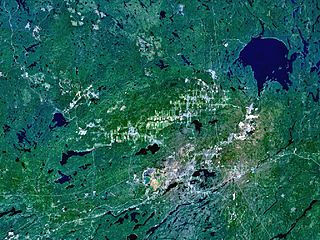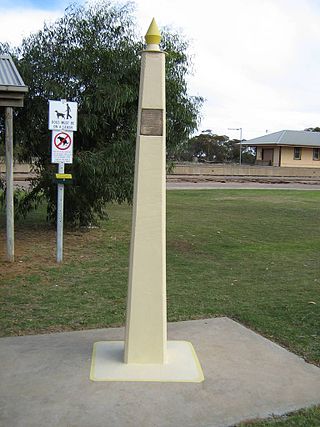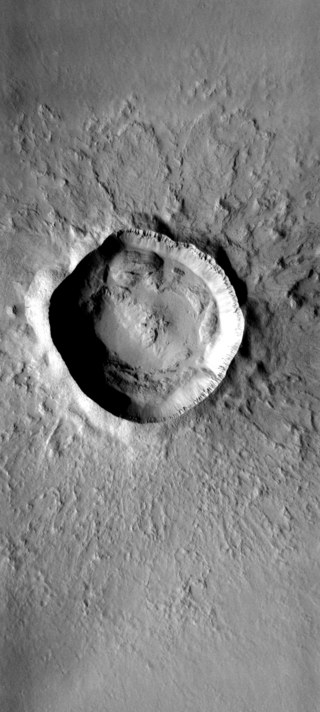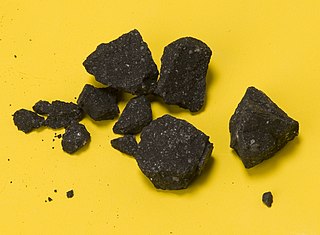
A meteorite is a solid piece of debris from an object, such as a comet, asteroid, or meteoroid, that originates in outer space and survives its passage through the atmosphere to reach the surface of a planet or moon. When the original object enters the atmosphere, various factors such as friction, pressure, and chemical interactions with the atmospheric gases cause it to heat up and radiate energy. It then becomes a meteor and forms a fireball, also known as a shooting star; astronomers call the brightest examples "bolides". Once it settles on the larger body's surface, the meteor becomes a meteorite. Meteorites vary greatly in size. For geologists, a bolide is a meteorite large enough to create an impact crater.

The Tunguska event was a 3–5 megaton explosion that occurred near the Podkamennaya Tunguska River in Yeniseysk Governorate, Russia, on the morning of 30 June 1908. The explosion over the sparsely populated East Siberian taiga flattened an estimated 80 million trees over an area of 2,150 km2 (830 sq mi) of forest, and low quality eyewitness data implies that up to three people may have possibly died in the event. The explosion is generally attributed to a meteor air burst: the atmospheric explosion of a stony asteroid about 50–60 metres in size. The asteroid approached from the east-south-east, and probably with a relatively high speed of about 27 km/s (60,000 mph). Though it is classified as an impact event, the object is thought to have exploded at an altitude of 5 to 10 kilometres rather than having hit the Earth's surface, leaving no impact crater.

An impact event is a collision between astronomical objects causing measurable effects. Impact events have physical consequences and have been found to regularly occur in planetary systems, though the most frequent involve asteroids, comets or meteoroids and have minimal effect. When large objects impact terrestrial planets such as the Earth, there can be significant physical and biospheric consequences, as the impacting body is usually traveling at several kilometres a second, though atmospheres mitigate many surface impacts through atmospheric entry. Impact craters and structures are dominant landforms on many of the Solar System's solid objects and present the strongest empirical evidence for their frequency and scale.
A V-type asteroid or Vestoid is an asteroid whose spectral type is that of 4 Vesta. Approximately 6% of main-belt asteroids are vestoids, with Vesta being by far the largest of them. They are relatively bright, and rather similar to the more common S-type asteroid, which are also made up of stony irons and ordinary chondrites, with V-types containing more pyroxene than S-types.

The Sudbury Basin, also known as Sudbury Structure or the Sudbury Nickel Irruptive, is a major geological structure in Ontario, Canada. It is the third-largest known impact crater or astrobleme on Earth, as well as one of the oldest. The crater was formed 1.849 billion years ago in the Paleoproterozoic era.
The Morokweng impact structure is an impact structure buried beneath the Kalahari Desert near the town of Morokweng in South Africa's North West province, close to the border with Botswana.

Neugrund is a meteorite crater in Estonia. It is 8 km (5.0 mi) in diameter and was previously estimated to have been formed in the Ordovician around 470 Ma, with later research revealing a possible Cambrian origin. The crater is at the bottom of the sea and is not exposed at the surface. Boulders of gneissic breccia found on the coast of Osmussaar, a nearby island, are believed to have been thrown there by the explosion. It has been proposed that the Neugrund crater was created during the Ordovician meteor event when a hypothetical large asteroid transferred directly into a resonant orbit with Jupiter, which shifted its orbit to intercept Earth.

The L type ordinary chondrites are the second most common group of meteorites, accounting for approximately 35% of all those catalogued, and 40% of the ordinary chondrites. The ordinary chondrites are thought to have originated from three parent asteroids, with the fragments making up the H chondrite, L chondrite and LL chondrite groups respectively.

The Karoonda meteorite is a meteorite that fell to earth on 25 November 1930 at 10:53 pm near the South Australian town of Karoonda. It is of a rare composition, being carbonaceous chondrite, and is also rare in that it was found so soon after its landing. Several fragments are now held in the South Australian Museum in Adelaide.

Petrus Matheus Marie (Peter) Jenniskens is a Dutch-American astronomer and a senior research scientist at the Carl Sagan Center of the SETI Institute and at NASA Ames Research Center. He is an expert on meteor showers, and wrote the book Meteor Showers and their Parent Comets, published in 2006 and Atlas of Earth’s Meteor Showers, published in 2023. He is past president of Commission 22 of the International Astronomical Union (2012-2015) and was chair of the Working Group on Meteor Shower Nomenclature (2006–2012) after it was first established. Asteroid 42981 Jenniskens is named in his honor.

Zunil is an impact crater near the Cerberus Fossae on Mars, with a diameter of 10.26 kilometres. It is named after the town of Zunil in Guatemala. The crater is located in the Elysium quadrangle. Visible in images from the Viking 1 and Viking 2 Mars orbiters in the 1970s, Zunil was subsequently imaged at higher resolution for the first time by the Mars Global Surveyor (MGS) Mars Orbiter Camera (MOC) in 2000.

Whitecourt crater is a meteorite impact crater in central Alberta, Canada, located approximately 10 km (6.2 mi) southeast of the Town of Whitecourt within Woodlands County. It is remarkable for being unusually well-preserved for a crater of small size and relatively young age.

Neuschwanstein was an enstatite chondrite meteorite that fell to Earth on 6 April 2002 at 22:20:18 GMT near Neuschwanstein Castle, Bavaria, at the Germany–Austria border.

Peace River is a L6 chondrite meteorite fall on the morning of March 31, 1963.

The Sutter's Mill meteorite is a carbonaceous chondrite which entered the Earth's atmosphere and broke up at about 07:51 Pacific Time on April 22, 2012, with fragments landing in the United States. The name comes from Sutter's Mill, a California Gold Rush site, near which some pieces were recovered. Meteor astronomer Peter Jenniskens assigned Sutter's Mill (SM) numbers to each meteorite, with the documented find location preserving information about where a given meteorite was located in the impacting meteoroid. As of May 2014, 79 fragments had been publicly documented with a find location. The largest (SM53) weighs 205 grams (7.2 oz), and the second largest (SM50) weighs 42 grams (1.5 oz).

The Novato meteorite is an ordinary chondrite which entered the Earth's atmosphere and broke up over Northern California at 19:44 Pacific Time on 17 October 2012. The falling bolide created a bright fireball and sonic booms and fragmented into smaller pieces as the intense friction of passing through the atmosphere heated it and absorbed its kinetic energy. The meteoroid was about 35 centimeters (14 in) across.
This is a glossary of terms used in meteoritics, the science of meteorites.

The Winchcombe meteorite is a carbonaceous chondrite meteorite that was observed entering the Earth's atmosphere as a fluorescent green fireball over Gloucestershire, England, at 21:54 hours on 28 February 2021. Due to a public appeal, fragments were quickly recovered from the village of Winchcombe, enabling it to be collected for analysis before becoming degraded.

2022 WJ1, formerly designated C8FF042, was a small, harmless ≈1-metre near-Earth asteroid or meteoroid that impacted Earth's atmosphere on 19 November 2022 at 08:27 UT in Southern Ontario, Canada, above the Golden Horseshoe region, southwest of Toronto. Meteorites were detected by weather radar during dark flight.

















